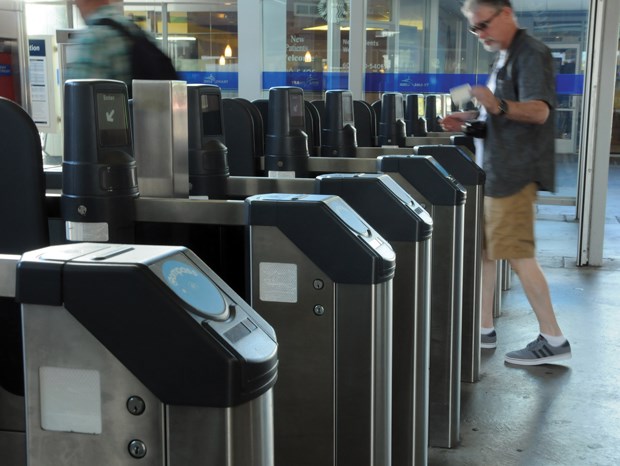Attention all SeaBus and SkyTrain commuters: Your grace period is over.
TransLink will be closing all of its fare gates, starting on April 4 and the only way through will be with a Compass Card or Compass tickets.
The fare gate and smartcard system, imposed by former transportation minister Kevin Falcon in 2007, has been in testing since February.
“It’s going well,” said Jennifer Moreland, TransLink spokeswoman. “Since then, we’ve done close to 50 successful SkyTrain gate closure demonstrations.”
Michael Doherty, a Vancouver lawyer who commutes on the SeaBus daily, said those testing events have gone better than expected, given the troubled nature of the Compass Card program.
“I do think the entire fare gate experience has been a complete debacle but it is not as slow as I thought it would be,” he said.
The one exception, Doherty said, is when Waterfront Station has a SkyTrain, SeaBus and West Coast Express all arriving at the same time and a bottleneck more akin to the Lions Gate Bridge begins to form.
“We’re all shuffling forward for maybe a minute and a half,” he said. “But I do feel sorry for anybody who’s on the other side. ... If a thousand people are going through in one direction, good luck trying to get through in the other direction.”
In early March, Peter Fassbender, the minister responsible for TransLink, said the transit authority wouldn’t be allowed to close the gates until it could guarantee the system would stay accessible for people with disabilities.
That’s something TransLink can commit to, Moreland said, promising extra staff at all gated stations during rush-hour periods to assist anyone unable to tap in or out.
When staff are not available during off-peak hours, there will be one “accessible gate” that will remain open.
“Regardless of whether the gate’s open or not, it is a requirement for customers to have valid proof of payment in fare-paid zones,” Moreland said on the subject of would-be fare evaders hoping to sneak through the open gate. “As we have been doing, we’ll continue to have people out on the system that are checking fares and enforcing.”
Transit police and security will be armed with hand-held scanners able to check that SeaBus and SkyTrain riders have properly tapped in.
And TransLink is reminding its users – especially those on the North Shore – that the old paper bus transfers and FareSaver tickets won’t work on the fare gates. Bus riders will still be able to pay their way onboard with change but the transfer tickets won’t be valid at the SeaBus terminal. Those transit riders will end up having to pay twice for the same trip, Moreland warned.
“That’s why we’re encouraging all of our customers to get a Compass Card. You can store value you on there and you’re ready to go. Customers who do that will actually find they’re paying less than … they would have with cash,” Moreland said.
The changeover comes as ridership aboard the SeaBus may be, figuratively, heading south, according to a recently published customer survey by TransLink.
“Compared to the last two years, the number of trips made on SeaBus has dropped to an all-time low of 4.3 (average weekly) trips this quarter (down from 6.9 a year ago). This may have been influenced by the implementation of one-zone bus fare diverting riders from the two-zone SeaBus,” it stated.
But the survey used a small sample size of 171 users and was by no means a detailed study of rider behaviour, TransLink warned. An in-depth study on ridership is not due out until May or June.
When the North Shore News asked whether the zone change was affecting ridership in December, TransLink spokesman Chris Bryan said there was “no notable impact on ridership on SeaBus as a result of the shift to One Zone Bus Anywhere on Oct. 5.”
Comparing the four weeks following Oct. 5 versus the same period in 2014 showed a nearly identical average load - 141 in 2014, 142 in 2015. The average daily ridership rose slightly, from 13,915 to 14,097, TransLink said at the time and that there had been “no increase in reports of crowding on our downtown-bound routes,” spokesman Bryan said at the time.
– with files from Justin Beddall



